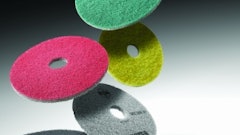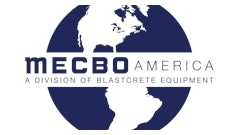
Selecting the right concrete processing attachments depends on an in-depth understanding of what is available and the latest technologies. There is a trade-off between the optimized performance of a dedicated tool vs. the versatility of a multi-process or universal tool.
"To make the right purchasing decision, the contractor should make sure he has a clear understanding of the performance specifications provided by the tool vendors," says Poul Rosengaard, sales & marketing consultant, Industrial & Work Tools Solutions, Caterpillar. "All too often the specifications are incomplete and vague."
One factor that has a direct impact on productivity is the ability to maintain processor teeth. "Regardless of what you do, the teeth are going to round down and become less effective," says Mark Ramun, director of the Demolition Tools Division at Genesis.
Northwest Demolition and Dismantling has experience with both pin-on and welded-on teeth. The company performs heavy industrial demolition and dismantling work in the Pacific Northwest and Hawaii. Four of its Stanley LaBounty Universal Processors have pin-on teeth segments, while the older half of its Universal Processor fleet has welded-on teeth. "I can't imagine why anybody today would go to a welded-on segment vs. one that can be knocked off in a matter of seconds and a new segment put on," says Brian Smith, president.
The units with welded-on teeth require more maintenance time. "If you are running 40-hour weeks, every Friday afternoon you should build up those wear surfaces, then hard-surface them," says Smith. "That can be four hours of welding time."
The concern with bolt-on teeth segments is that they may fall off. "If you do not train your operators and have a good maintenance program, nothing is going to stay together," says Smith. "Replace them before they are worn out and you minimize that risk. We have lost them because they were excessively worn."
Uwe Kausch, Stanley LaBounty, says his company's Swift Lock (pin-on) teeth can be un-pinned, built up and hardfaced, if the contractor so chooses. "In fact, many contractors will buy two sets of teeth and rotate them out for maintenance on a regular schedule. The advantage of pin-on teeth is that you only lose a small amount of production time since it only takes a half hour to change them out," he explains.
Without preventive maintenance, there is a possibility that pin-on teeth can fall off. "All of the bolt-on teeth systems I have seen use a cast bed and a cast tooth," says Ramun. "There is no machining work done between the two parts, which means there is inherent slop between them. Because they are bolt on, there are inherent issues with them falling out prematurely or breaking."
For this reason, Genesis has chosen a different tooth system. Instead of having sets of bolt-in teeth, it offers products where the whole bed of teeth is bolted in from the protected backside of the pulverizing and crushing jaws. "It is not individual teeth, it is the actual bed," says Ramun. You have a lot more bolts and you have a lot more surface area, so you stand a very low chance of actually losing the whole bed."
Versatility vs. performance
When it come to choosing between dedicated attachments and universal tools, you must weigh versatility against performance.
Smith reports that a Universal Processor for a 100,000-lb. excavator costs approximately $125,000, depending upon how Northwest Demolition has it equipped. "If you have a dedicated shear and a dedicated processor, you just doubled the cost of that investment to do the same thing. You have a shear that sits idle while you use the processor, or you have another machine to hang it on," he explains. "I can send one machine to a job and cut all of the steel out of a building. I drop that attachment and put on a bucket to pull the footings. Then I put the attachment back on, pull out the jaws and put in pulverizer jaws. Next, I reduce the footings down to gravel and take the reinforcing steel out.
"With one attachment and one machine, I can do the work of three machines," Smith continues. The key is utilization. "If you have $100,000 invested in that attachment, you want to keep it working. If you have to set it on the ground and put on another attachment because you don't have the right capacity, that is not good utilization. The money in our business is making this stuff work."
It does take substantial effort to change jaw sets. If two people really work at it, they can change jaws on a Universal Processor in an hour, says Smith.
But the attachment has proven beneficial. "Anybody who is in our business and doesn't have one, I can't imagine how they can compete," Smith comments. "I think you are going to see more general contractors start to look at them."
Yet, there are trade-offs to using a universal attachment vs. a dedicated tool due to the inability to optimize the geometry for every application. The geometry of the hydraulic cylinder acting on the linkages of the attachment determines the attachment's power curve. Due to the linkage, this power curve is not linear.
"They produce a bell curve," explains Ramun. "The cylinder builds power until those links are 90° with the cylinder." From that point on, the power drops off because you lose leverage.
This power curve can be shifted by changing the linkage, and therefore the point where the cylinder is 90° in respect to the linkage. "It is very important where you place the peak of the bell curve when you are talking about these tools," says Ramun. "A pulverizer, or a concrete-designed tool, should start out with its bell curve peaking. If you have a 30-in. opening, you want to design your tool to be able to grab onto a 30-in. column and crush it. Concrete, as it starts to fracture, obviously gets easier to break. You need the most power to crack it."
The power curve for a shear is the exact opposite. The power needs to be at the back end to pierce the steel.
"The dilemma is that all of the tools out there right now have fixed power curves," says Ramun. A dedicated concrete tool is optimized with a front-loaded power curve, while a dedicated shear is optimized with a rear-loaded power curve. The multi-processor must compromise one way or the other.
"If you design a tool to be a universal tool, you typically put the power curve in the front, so it performs best when it has the concrete jaw in it," says Ramun. "Secondarily, you can throw a shear jaw set in there and it has the ability to cut steel. That's why anybody who is being truthful with you will say their universal tools perform much better in concrete than they do in steel."
Genesis has addressed this dilemma with the introduction of its Logix Processor. "Our LXP line of processors are available with both shear and pulverizer jaw sets," says Ramun. "We have actually overcome the engineering hurdle of having a fixed power curve in an interchangeable jaw set design. We don't require the tool to be disassembled at the main pivot. We leave the main pivots with the jaw sets. Because we are doing that, we can alter the relationship of where we are putting the main pivot. We can alter the approach angle of the lever arm to the cylinders."
With current designs, the decrease associated with shear performance is often more than a fair trade-off for increased versatility. "In engineering, everything is a trade-off, so you give up something to do that," says Smith. "You give up a little bit of capacity in the shear going to a unit that has replaceable jaws."
D.H. Griffin is one of the largest demolition contractors in the United States. This diversified demolition company uses a mix of standardized attachments and Universal Processors from Stanley LaBounty.
Usage varies by territory. "It depends on the market you are in," says David Griffin Jr., president. "Our markets in the Midwest tend to have more standardized shear attachments. But for most of the markets we work in the South, the Universal Processor seems more versatile."
This is due to the nature of the projects in each region. "In the Midwest, we do more industrial plant demolition," says Griffin. The performance of the shears is more important in these applications, and the company tends to cut thicker steel.
"The South is more a mix of highway, commercial and industrial, so the Universal Processor serves a better purpose," says Griffin. "For us, the trade-off is worth it [in this territory]. You may not cut as thick a piece of steel, but two hours later, you can change the jaws out and munch a 14-in. concrete wall."
|
Customize the Carrier Northwest Demolition and Dismantling has maximized the efficiency and safety of its LaBounty Universal Processors by customizing its excavators for the task. "We buy new machines from Komatsu, and before we ever use them, we send them to Jewell Mfg., a fabricating company here in Portland," says Brian Smith, president. Smith explains that to some degree the Universal Processor needs to be married to the machine. "We spend $50,000 to $70,000 on a machine modifying it if we are going to put a LaBounty [Universal Processor] on it. Jewell counterweights the machines. It changes the hydraulics. It custom builds the booms and sticks for us," says Smith. It also installs custom guards for the engine and operator. "There is always a concern that you are going to get fragments flying. As a result, on all of our equipment, we have special canopies and guards built for the operators." In addition, Jewell adds generators for magnets. The Universal Processor can then be switched with a magnet to clean up metal debris left on the jobsite. Northwest Demolition uses two long-stick machines in addition to several shorter stick machines. "We even counterweight the machines that don't have longer sticks," says Smith. "Otherwise, the machine tends to rock. If you are trying to take an attachment and reach out to do something, what does that do to your productivity?" The long-stick machines allow increased capability. "It used to be that a three-story building was a big deal," recalls Smith. But with the LaBounty Universal Processors mounted on long-stick machines, the company can now reach eight-story buildings. "Today, we use a long-stick with an attachment and we take those buildings down very quickly with relative safety. When the material hits the ground, it has already been downsized and it's ready to go into a crushing plant." But not all operators should be turned loose on a long-stick excavator. "If you don't have a very savvy operator, he is either going to lay the machine over or have premature collapse of the building," says Smith. "We are very cautious about who we let on the long sticks." He adds that incidents with these machines are largely due to human error. "In most cases, you have to say that it is due to a lack of operator training." |
|
Power-to-weight Ratio Explained "When evaluating tools for mounting on an excavator in any given weight class, the force-to-weight ratio is probably the most important ratio, provided the force of the tool is properly defined," says Poul Rosengaard, Industrial & Work Tools Solutions, Caterpillar. "This ratio is a very good indication of the productivity of the tool. The ratio is easily calculated by dividing the crushing arm torque (expressed in ft.-lbs. developed) by the weight of the tool, including the mounting bracket." Stanley LaBounty uses Finite Element Analysis (FEA) in conjunction with strain gauges to optimize the power-to-weight ratio. "What FEA allows us to do is put the weight where it is absolutely necessary and take out weight where it is not necessary," says Uwe Kausch. "You have to make the tool live, yet you want maximum performance. FEA has taken a lot of the guesswork out of it." Kausch explains that more power typically yields better performance in primary demolition work. "But in recycling material, it is probably more speed, depending upon the size of the material," he notes. Even though a Universal Processor is typically used for primary demolition, the addition of speed valves to close the jaw have increased productivity. So the power-to-weight ratio should not be the only consideration. "Power-to-weight ratio is what the industry manufacturers have tried to [use as] an apples to apples comparison of tools," says Mark Ramun at Genesis. "But it is not necessarily accurate. You can have a 10,000-lb. attachment with the same power as my 12,000-lb. attachment. You would have a higher power-to-weight ratio. That doesn't necessarily mean that your tool would be better for a particular application. Maybe your 10,000-lb. tool is 2 1/2 ft. longer than mine. Its center of gravity is actually further away from the machine. So your attachment could actually be heavier on the machine than mine. In concrete applications, power-to-weight ratios are usually not real important." Design of the attachment jaws also plays an influential role in the actual performance. "Tip force depends on the tool arm torque divided by the distance of the tip from the center of rotation of the moving jaw," says Rosengaard. "Obviously, the longer the jaw, the more concrete can be placed in the tool. On the other hand, the greater the jaw depth, the lower the tip force. Since the tool crushing force is lowest at the tip, which is also the point in the jaw where the thickest concrete can be accommodated, it's an important parameter. In many ways, it's absurd that tool companies stress tool throat force since at the throat virtually no material can be processed. "Caterpillar has attempted to provide an unambiguous force specification by publishing the tool arm torque of the Cat shears and Multi Processors," Rosengaard adds. "This torque is the force developed by the tool cylinder multiplied by the tool lever arm. The actual force at any point along the shear arm can easily be calculated by dividing the arm torque by the distance from the center of rotation of the moving jaw to the point at which the force is to be measured." It is possible to have a high throat force and a low tip force due to a greater jaw depth. "This is important when cutting steel with dimensions exceeding the jaw depth," says Rosengaard. The attachment needs adequate tip force to pierce the steel. "If the operator cannot pierce the plate, he cannot cut the plate either." |



























